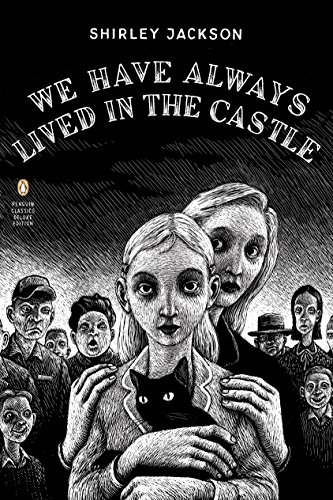We Have Always Lived In the Castle, by Shirley Jackson
May 28
2019

A recent film adaptation has renewed interest in Shirley Jackson's 1962 novella We Have Always Lived in the Castle. As a scary-movie weenie, I stuck to reading the synopsis... which ended up irritating me in its own right, because Jackson's story didn't actually need a bunch of tacked-on action/horror sequences to be creepy as hell.
We Have Always Lived in the Castle is the story of the Blackwood family: sisters Merricat and Constance and their ailing uncle Julian. Six years earlier, the rest of the Blackwood family was fatally poisoned, and Constance was accused of the crime. While she was eventually acquitted, Constance no longer leaves the family's property, leaving 18-year-old Merricat as the Blackwoods' only visitor to the nearby village. But when the sisters' confident, insinuating cousin invites himself to stay, the routines and rituals of Merricat and Constance's daily lives are suddenly turned upside down.
As the story's POV character, Merricat's depiction of the family's life is idyllic, free from worries about money, romance, or outsiders. Apart from her weekly trips into the village (where she runs the risk of encountering confrontational neighbors), Merricat seems to lead a charmed life. But as Jackson's story progresses, it becomes clear that the true horror of the Blackwood sisters' existence lies between the coziness and whimsy of her world as Merricat perceives it, and that world as it actually exists.
SPOILERS AHEAD: While I really enjoyed most of We Have Always Lived in the Castle, I was equally intrigued and frustrated by Jackson's depiction of Constance. Throughout the story, there are steady hints that she is considering leaving her self-imposed isolation, but she consistently chooses to hide away with her disturbed little sister and paralyzed uncle. Constance is simultaneously the most disturbing and compelling character in the story, and I wish Jackson had fleshed her out more, because in the end she's all gothic drama with no logical payoff.
We Have Always Lived in the Castle is the story of the Blackwood family: sisters Merricat and Constance and their ailing uncle Julian. Six years earlier, the rest of the Blackwood family was fatally poisoned, and Constance was accused of the crime. While she was eventually acquitted, Constance no longer leaves the family's property, leaving 18-year-old Merricat as the Blackwoods' only visitor to the nearby village. But when the sisters' confident, insinuating cousin invites himself to stay, the routines and rituals of Merricat and Constance's daily lives are suddenly turned upside down.
As the story's POV character, Merricat's depiction of the family's life is idyllic, free from worries about money, romance, or outsiders. Apart from her weekly trips into the village (where she runs the risk of encountering confrontational neighbors), Merricat seems to lead a charmed life. But as Jackson's story progresses, it becomes clear that the true horror of the Blackwood sisters' existence lies between the coziness and whimsy of her world as Merricat perceives it, and that world as it actually exists.
SPOILERS AHEAD: While I really enjoyed most of We Have Always Lived in the Castle, I was equally intrigued and frustrated by Jackson's depiction of Constance. Throughout the story, there are steady hints that she is considering leaving her self-imposed isolation, but she consistently chooses to hide away with her disturbed little sister and paralyzed uncle. Constance is simultaneously the most disturbing and compelling character in the story, and I wish Jackson had fleshed her out more, because in the end she's all gothic drama with no logical payoff.
Posted by: Julianka
No new comments are allowed on this post.
Comments
No comments yet. Be the first!